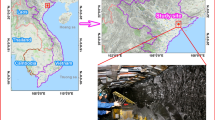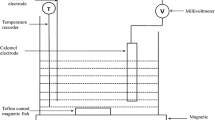Abstract
Coal, as an initial source of energy, requires a detailed investigation in terms of ultimate analysis, proximate analysis, and its biological constituents (macerals). The rank and calorific value of each type of coal are managed by the mentioned properties. In contrast to ultimate and proximate analyses, determining the macerals in coal requires sophisticated microscopic instrumentation and expertise. This study emphasizes the estimation of the concentration of macerals of Indian coals based on a hybrid imperialism competitive algorithm (ICA)–artificial neural network (ANN). Here, ICA is utilized to adjust the weight and bias of ANNs for enhancing their performance capacity. For comparison purposes, a pre-developed ANN model is also proposed. Checking the performance prediction of the developed models is performed through several performance indices, i.e., coefficient of determination (R 2), root mean square error and variance account for. The obtained results revealed higher accuracy of the proposed hybrid ICA-ANN model in estimating macerals contents of Indian coals compared to the pre-developed ANN technique. Results of the developed ANN model based on R 2 values of training datasets were obtained as 0.961, 0.955, and 0.961 for predicting vitrinite, liptinite, and inertinite, respectively, whereas these values were achieved as 0.948, 0.947, and 0.957, respectively, for testing datasets. Similarly, R 2 values of 0.988, 0.983, and 0.991 for training datasets and 0.989, 0.982, and 0.985 for testing datasets were obtained from developed ICA-ANN model.









Similar content being viewed by others
References
Ahmadi MA, Ebadi M, Shokrollahi A, Majidi SMJ (2013) Evolving artificial neural network and imperialist competitive algorithm for prediction oil flow rate of the reservoir. Appl Soft Comput 13(2):1085–1098
Atashpaz-Gargari, E (2008) Developing a socially inspired optimization algorithm, Master thesis (in persian), University of Tehran, Iran
Atashpaz-Gargari E, Lucas C (2007) Imperialist competitive algorithm: an algorithm for optimization inspired by imperialistic competition. In: IEEE congress on evolutionary computation pp 4661–4667
Baheer I (2000) Selection of methodology for modeling hysteresis behavior of soils using neural networks. J Comput Aid Civ Infrastruct Eng 5(6):445–463
Balan HO, Gumrah F (2009) Assessment of shrinkage-swelling influences in coal seams using rank-dependent physical coal properties. Int J Coal Geol 77:203–213
Demuth H, Beale M, Hagan M (2009) MATLAB Version 7.14.0.739; Neural Network Toolbox for Use with Matlab. The Mathworks
Dreyfus G (2005) Neural networks: methodology and application. Springer, Berlin
Du KL, Lai AKY, Cheng KKM, Swamy MNS (2002) Neural methods for antenna array signal processing: a review. Signal Process 82:547–561
Eberhart RC, Shi Y (1998) Evolving artificial neural networks. In: Proceedings of the international conference on neural networks and brain, pp PL5–PL13
Ebrahimi E, Mollazade K, Babaei S (2014) Toward an automatic wheat purity-measuring device: a machine vision-based neural networks-assisted imperialist competitive algorithm approach. Measurement 55:196–205
Fausett LV (1994) Fundamentals of neural networks: architecture, algorithms and applications. Prentice-Hall, Englewood Cliffs
Ghasemi E, Ataei M, Hashemolhosseini H (2013) Development of a fuzzy model for predicting ground vibration caused by rock blasting in surface mining. J Vib Control 19(5):755–770
Gordan B, Armaghani DJ, Hajihassani M, Monjezi M (2016) Prediction of seismic slope stability through combination of particle swarm optimization and neural network. Eng Comput 32:85–97
Hajihassani M, Jahed Armaghani D, Marto A, Mohamad ET (2015) Ground vibration prediction in quarry blasting through an artificial neural network optimized by imperialist competitive algorithm. Bull Eng Geol Environ 74:873–886
Haykin S (1999) Neural Networks, 2nd edn. Prentice-Hall, Englewood Cliffs
Hecht-Nielsen R (1987) Kolmogorov’s mapping neural network existence theorem. In: Proceedings of the first IEEE international conference on neural networks, San Diego, CA, USA, pp 11–14
Hornik K, Stinchcombe M, White H (1989) Multilayer feedforward networks are universal approximators. Neural Netw 2:359–366
Hush DR (1989) Classification with neural networks: a performance analysis. In Proceedings of the IEEE international conference on systems engineering. Dayton, OH, USA, pp 277–280
Jahed Armaghani D, Mohamad ET, Hajihassani M, Abad SANK, Marto A, Moghaddam MR (2016a) Evaluation and prediction of flyrock resulting from blasting operations using empirical and computational methods. Eng Comput 32:109–121
Jahed Armaghani D, Hasanipanah M, Mohamad ET (2016b) A combination of the ICA-ANN model to predict air-overpressure resulting from blasting. Eng Comput 32(1):155–171
Jahed Armaghani D, Raja Shoib RSNS, Faizi K, Rashid ASA (2017) Developing a hybrid PSO-ANN model for estimating the ultimate bearing capacity of rock-socketed piles. Neural Comput Appl 28:391–405
Kaastra I, Boyd M (1996) Designing a neural network for forecasting financial and economic time series. Neurocomputing 10:215–236
Kalinli A, Acar MC, Gunduz Z (2011) New approaches to determine the ultimate bearing capacity of shallow foundations based on artificial neural networks and ant colony optimization. Eng Geol 117:29–38
Kalkreuth W, Sherwood N, Cioccari G, da Silva Correa, Silva M, Zhong N et al (2004) The application of FAMM (fluorescence alteration of multiple macerals) analyses for evaluating rank of Parana Basin coals, Brazil. Int J Coal Geol 57:165–185
Kanellopoulas I, Wilkinson GG (1997) Strategies and best practice for neural network image classification. Int J Remote Sens 18:711–725
Khamesi H, Torabi S, Mirzaei-Nasirabad H, Ghadiri Z (2015) Improving the performance of intelligent back analysis for tunneling using optimized fuzzy systems: case study of the Karaj Subway Line 2 in Iran. J Comput Civ Eng 29(6):05014010
Khandelwal M (2011) Blast-induced ground vibration prediction using support vector machine. Eng Comput 27(3):193–200
Khandelwal M, Jahed Armaghani D (2016) Prediction of drillability of rocks with strength properties using a hybrid GA-ANN technique. Geotech Geol Eng 34(2):605–620
Khandelwal M, Monjezi M (2013) Prediction of backbreak in open-pit blasting operations using the machine learning method. Rock Mech Rock Eng 46(2):389–396
Khandelwal M, Singh TN (2010) Prediction of macerals contents of Indian coals from proximate and ultimate analyses using artificial neural networks. Fuel 89(5):1101–1109
Kuo RJ, Wang YC, Tien FC (2010) Integration of artificial neural network and MADA methods for green supplier selection. J Clean Prod 18(12):1161–1170
Looney CG (1996) Advances in feed-forward neural networks: demystifying knowledge acquiring black boxes. IEEE Trans Knowl Data Eng 8(2):211–226
Lynch LJ (1989) Introductory perspective: characterization of sedimentary organic matter through true definition of macerals. In: Thomas CG, Strachan MG, (eds) The effect of macerals on the utilization of coal and their significance in petroleum exploration: a symposium, p 1–3
Marto A, Hajihassani M, Jahed Armaghani D, Tonnizam Mohamad E, Makhtar AM (2014) A novel approach for blast-induced flyrock prediction based on imperialist competitive algorithm and artificial neural network. Sci. World. J, Article ID 643715
Masters T (1994) Practical neural network recipes in C++. Academic Press, Boston
Maulenkamp F, Grima MA (1999) Application of neural networks for the prediction of the unconfined compressive strength (UCS) from Equotip hardness. Int J Rock Mech Min Sci 36:29–39
Mohanty JK, Misra SK, Nayak BB (2001) Sequential leaching of trace elements in coal: a case study from Talcher coal field, Orissa. J Geol Soc India 58:441–447
Momeni E, Nazir R, Jahed Armaghani D, Maizir H (2015) Application of artificial neural network for predicting shaft and tip resistances of concrete piles. Earth Sci Res J 19(1):85–93
Mukherjee AK, Alam MM, Ghose S (1988) Gondwana coals of Bhutan Himalaya –occurrence, properties and petrographic characteristics. Int J Coal Geol 9:287–304
Mukherjee AK, Alum MM, Mazumdar SK, Haque R, Gowrisankaran S (1992) Physicochemical properties and petrographic characteristics of the Kapurdi lignite deposit, Barmer Basin, Rajasthan, India. Int J Coal Geol 21:31–44
Nelson M, Illingworth WT (1990) A practical guide to neural nets. Addison-Wesley, Reading
Ornek M, Laman M, Demir A, Yildiz A (2012) Prediction of bearing capacity of circular footings on soft clay stabilized with granular soil. Soil Found 52(1):69–80
Panigrahi DC, Sahu HB (2004) Application of hierarchical clustering for classification of coal seams with respect to their proneness to spontaneous heating. Min Technol (Trans Inst Min Metal A) 113:97–106
Paola JD (1994) Neural network classification of multispectral imagery. M.Sc. thesis, The University of Arizona, USA
Pareek HS (1983) Chemico-petrographic studies of some lignite samples from kalol oilfield, Cambay Basin, Gujarat, Western India. Int J Coal Geol 3:183–204
Parikh J, Channiwala SA, Ghosal GK (2005) A correlation for calculating HHV from proximate analysis of solid fuels. Fuel 84:487–494
Pearson DE (1991) Probability analysis of blended coking coals. Int J Coal Geol 19:109–119
Rai KL, Shukla RT (1979) Depositional environment and origin of coal in Pench–Kanhan valley coalfield, M.P., India. In: Proceedings of the 4th international Gondwana symposium, Geological Survey of India, Calcutta, vol. 1, p 256–74
Ravi V, Reddy PJ (1999) Ranking of Indian coals via fuzzy multi attribute decision making. Fuzzy Sets Syst 103:369–377
Ripley BD (1993) Statistical aspects of neural networks. In: Barndoff- Neilsen OE, Jensen JL, Kendall WS (eds) Networks and chaos-statistical and probabilistic aspects. Chapman & Hall, London, pp 40–123
Sari M, Ghasemi E, Ataei M (2014) Stochastic modeling approach for the evaluation of backbreak due to blasting operations in open pit mines. Rock Mech Rock Eng 47(2):771–783
Shahin MA, Maier HR, Jaksa MB (2002) Predicting settlement of shallow foundations using neural networks. J Geotech Geoenviron Eng 128(9):785–793
Sharma NL, Ram KSV (1966) A handbook of introduction to the geology of coal and Indian coal fields, 2nd edn. Indian School of mines, Dhanbad
Simpson PK (1990) Artificial neural system: foundation, paradigms, applications and implementations. Pergamon, New York
Sonmez H, Gokceoglu C, Nefeslioglu HA, Kayabasi A (2006) Estimation of rock modulus: for intact rocks with an artificial neural network and for rock masses with a new empirical equation. Int J Rock Mech Min Sci 43:224–235
Swingler K (1996) Applying neural networks: a practical guide. Academic Press, New York
Takahashi R, Sasaki M (1989) Automatic macerals analysis of low-rank coal (brown coal). Int J Coal Geol 14:103–118
Tonnizam Mohamad E, Armaghani DJ, Noorani SA, Saad R, Alvi Nezhad SV (2012) Prediction of flyrock in boulder blasting using artificial neural network. EJGE 17:2585–2595
Vasconcelos Lopo de Sousa (1999) The petrographic composition of world coals: statistical results obtained from a literature survey with reference to coal type (maceral composition). Int J Coal Geol 40:27–59
Wang C (1994) A theory of generalization in learning machines with neural application. Ph.D. thesis, The University of Pennsylvania, USA
Zorlu K, Gokceoglu C, Ocakoglu F, Nefeslioglu HA, Acikalin S (2008) Prediction of uniaxial compressive strength of sandstones using petrography-based models. Eng Geol 96(3–4):141–158
Author information
Authors and Affiliations
Corresponding author
Rights and permissions
About this article
Cite this article
Khandelwal, M., Mahdiyar, A., Armaghani, D.J. et al. An expert system based on hybrid ICA-ANN technique to estimate macerals contents of Indian coals. Environ Earth Sci 76, 399 (2017). https://doi.org/10.1007/s12665-017-6726-2
Received:
Accepted:
Published:
DOI: https://doi.org/10.1007/s12665-017-6726-2




